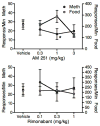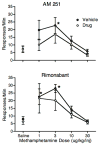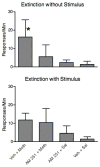Effects of cannabinoid receptor antagonists on maintenance and reinstatement of methamphetamine self-administration in rhesus monkeys
- PMID: 20153314
- PMCID: PMC2974174
- DOI: 10.1016/j.ejphar.2010.02.005
Effects of cannabinoid receptor antagonists on maintenance and reinstatement of methamphetamine self-administration in rhesus monkeys
Abstract
Cannabinoid receptor antagonists have shown some promise as treatments capable of reducing abuse and relapse to a number of abused drugs. In rodents, such effects have been observed with methamphetamine self-administration. However, the effects of cannabinoid receptor antagonists on methamphetamine self-administration and relapse have not been studied in primates. In the present study, rhesus monkeys were trained to respond on a three-component operant schedule. During the first 5-min component, fixed-ratio responses were reinforced by food, during the second 90- or 180-min component fixed-ratio responses were reinforced by i.v. methamphetamine. The third component was identical to the first. There was a 5-min timeout between each component. The effects of the cannabinoid receptor antagonists AM 251 and rimonabant were tested at various doses against self-administration of 3microg/kg/injection methamphetamine, and 1mg/kg AM 251 and 0.3mg/kg rimonabant were tested against the methamphetamine dose-effect function. The 1mg/kg dose of AM 251 was also tested for its ability to alter reinstatement of extinguished self-administration responding. The cannabinoid receptor antagonist AM 251 was found to reduce methamphetamine self-administration at doses that did not affect food-reinforced responding. The cannabinoid receptor antagonist rimonabant had similar, but less robust effects. AM 251 also prevented reinstatement of extinguished methamphetamine seeking that was induced by re-exposure to a combination of methamphetamine and methamphetamine-associated cues. These results indicate that cannabinoid receptor antagonists might have therapeutic effects for the treatment of methamphetamine dependence.
Copyright 2010. Published by Elsevier B.V.
Figures



Similar articles
-
The CB1 antagonist rimonabant (SR141716) blocks cue-induced reinstatement of cocaine seeking and other context and extinction phenomena predictive of relapse.Drug Alcohol Depend. 2009 Dec 1;105(3):248-55. doi: 10.1016/j.drugalcdep.2009.07.002. Epub 2009 Aug 12. Drug Alcohol Depend. 2009. PMID: 19679410 Free PMC article.
-
Contextual renewal of nicotine seeking in rats and its suppression by the cannabinoid-1 receptor antagonist Rimonabant (SR141716A).Neuropharmacology. 2008 Oct;55(5):712-6. doi: 10.1016/j.neuropharm.2008.06.003. Epub 2008 Jun 7. Neuropharmacology. 2008. PMID: 18588903
-
Prevention of drug priming- and cue-induced reinstatement of MDMA-seeking behaviors by the CB1 cannabinoid receptor antagonist AM251.Drug Alcohol Depend. 2016 Mar 1;160:76-81. doi: 10.1016/j.drugalcdep.2015.12.016. Epub 2015 Dec 30. Drug Alcohol Depend. 2016. PMID: 26796595
-
Cannabinoid receptor stimulation increases motivation for nicotine and nicotine seeking.Addict Biol. 2012 Jan;17(1):47-61. doi: 10.1111/j.1369-1600.2011.00314.x. Epub 2011 Apr 26. Addict Biol. 2012. PMID: 21521420
-
Blockade of Nicotine and Cannabinoid Reinforcement and Relapse by a Cannabinoid CB1-Receptor Neutral Antagonist AM4113 and Inverse Agonist Rimonabant in Squirrel Monkeys.Neuropsychopharmacology. 2016 Aug;41(9):2283-93. doi: 10.1038/npp.2016.27. Epub 2016 Feb 18. Neuropsychopharmacology. 2016. PMID: 26888056 Free PMC article.
Cited by
-
Effects of the cannabinoid CB₁ receptor allosteric modulator ORG 27569 on reinstatement of cocaine- and methamphetamine-seeking behavior in rats.Drug Alcohol Depend. 2014 Oct 1;143:251-6. doi: 10.1016/j.drugalcdep.2014.08.004. Epub 2014 Aug 17. Drug Alcohol Depend. 2014. PMID: 25169627 Free PMC article.
-
Cannabinoid Type 1 Receptors in the Basolateral Amygdala Regulate ACPA-Induced Place Preference and Anxiolytic-Like Behaviors.Neurochem Res. 2022 Sep;47(9):2899-2908. doi: 10.1007/s11064-022-03708-8. Epub 2022 Aug 19. Neurochem Res. 2022. PMID: 35984590
-
Screening Medications for the Treatment of Cannabis Use Disorder.Int Rev Neurobiol. 2016;126:87-120. doi: 10.1016/bs.irn.2016.02.005. Epub 2016 Mar 10. Int Rev Neurobiol. 2016. PMID: 27055612 Free PMC article. Review.
-
Inhibition of FAAH and activation of PPAR: new approaches to the treatment of cognitive dysfunction and drug addiction.Pharmacol Ther. 2013 Apr;138(1):84-102. doi: 10.1016/j.pharmthera.2013.01.003. Epub 2013 Jan 16. Pharmacol Ther. 2013. PMID: 23333350 Free PMC article. Review.
-
The great divide: Separation between in vitro and in vivo effects of PSNCBAM-based CB1 receptor allosteric modulators.Neuropharmacology. 2017 Oct;125:365-375. doi: 10.1016/j.neuropharm.2017.08.008. Epub 2017 Aug 10. Neuropharmacology. 2017. PMID: 28803965 Free PMC article.
References
-
- Anggadiredja K, Nakamichi M, Hiranita T, Tanaka H, Shoyama Y, Watanabe S, Yamamoto T. Endocannabinoid system modulates relapse to methamphetamine seeking: possible mediation by the arachidonic acid cascade. Neuropsychopharmacology. 2004;29:1470–1478. - PubMed
-
- Beardsley PM, Thomas BF, McMahon LR. Cannabinoid CB1 receptor antagonists as potential pharmacotherapies for drug abuse disorders. Int Rev Psychiatry. 2009;21:134–142. - PubMed
-
- De Vries TJ, Schoffelmeer AN. Cannabinoid CB1 receptors control conditioned drug seeking. Trends Pharmacol Sci. 2005;26:420–426. - PubMed
-
- De Vries TJ, Shaham Y, Homberg JR, Crombag HS, Schuurman K, Dieben J, Vanderschuren LJ, Schoffelmeer AN. A cannabinoid mechanism in relapse to cocaine seeking. Nat Med. 2001;7:1151–1154. - PubMed
Publication types
MeSH terms
Substances
Grants and funding
LinkOut - more resources
Full Text Sources
Other Literature Sources
Medical

